
Key Benefits and Total Rewards Communications to Prioritize in 2023
Humans love stories about transformation. Narratives about the hero’s journey, where a character confronts obstacles, learns lessons, and emerges stronger and wiser, are pervasive in literature, television, and movies. I’ve always thought of transformation as a single event—the caterpillar turns into a butterfly and, boom, is on its way in the world. But a new book about business transformation following the COVID-19 crisis argues that “transformation is not a one-and-done event, but a continuous process of adapting to a volatile and uncertain environment.”
This idea of ongoing change in a world of uncertainty resonates deeply with me. Over the last few years, we’ve experienced profound change that’s influenced all aspects of our personal and professional lives—and we expect more change in the year ahead.
The global pandemic, war for talent, economic headwinds, and intensified commitment to diversity, equity, and inclusion have created more opportunities for HR and benefits professionals to leverage the significant roles that benefits and total rewards play in attracting and retaining people and for your HR people to demonstrate what your organization stands for to employees, customers, stakeholders, and stockholders. Plus, when employees understand how their benefits work, including what’s covered and what isn’t, they’re more likely to trust leadership, feel valued and appreciated, be satisfied with their jobs, and stay at their organization.
As more organizations implement return-to-office policies, all eyes will be on HR and benefits teams to successfully roll out policies that support where, when, and how we work, providing even more scrutiny and opportunity.
So, with all these significant challenges, how can you best focus your limited time and resources to support your people in the year ahead? Here are six key areas of communications to prioritize.
Tell Your Rewards Story
In any economic climate, employees (and potential candidates) want to understand how and where you’re investing in them. According to a MetLife survey, employees increasingly view flexibility; health and well-being programs; work-life balance; training, development, and advancement opportunities; and diversity and inclusion programs as must-haves. Pay transparency and how compensation works are other key topics. Consider pulling together your compensation philosophy with the resources you offer to support well-being, career growth, community, and belonging. Doing so will remind people about the valuable programs you offer—both monetary and non-monetary. Synopsys recently developed a guide to accomplish just this.
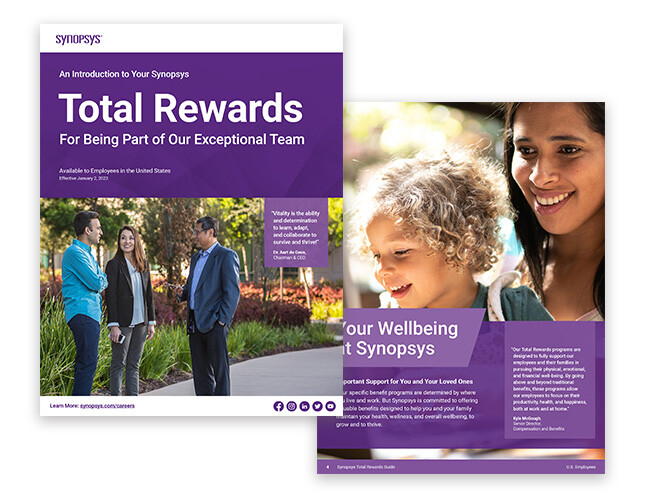
Synopsys Total Rewards guide
Ask Employees About What’s on Their Minds
If you don’t already know what your people are most focused on, getting feedback is always a great place to start. Ask them about what they’re worried about, whether they’re familiar with new programs you’ve introduced, and which benefits and programs they value most. Their responses will help you focus on where you should spend your time and energy. Are they overwhelmingly interested in learning more about your well-being programs? Are they asking for a benefit you already offer? Are they confused about your bonus formula and how you calculate pay raises? Let their responses guide your communications agenda.
Every year, Lenovo asks its employees a couple of questions following their annual enrollment. It was evident from employees’ responses to last year’s survey that people wanted to understand more about their financial benefits. Consequently, highlighting financial planning, resources to build emergency savings, retirement planning, and other financial resources will be a top priority in their future communications campaigns.
Deliver on Your Organizations’ Diversity, Equity, and Inclusion Goals
Benefits programs are a tangible way you can demonstrate your organization’s commitment to diversity, equity, and inclusion (DEI)—and help all your people feel like they belong. If you’re still developing your DEI strategy, consider taking our short assessment to identify your current strengths, weaknesses, and areas of opportunity. As we shared in a recent webinar about advancing DEI impact, there are many ways you can improve benefits equity across your organization. Benefits communications play an important role in signaling where you stand and what you offer. Consider:
- Using inclusive language, imagery, and delivery methods
- Promoting new or existing benefits designed to address DEI goals
- Targeting specific populations with relevant benefits
- Connecting with employer resource groups (ERGs) to drive awareness of programs and resources
Over the years, Lam Research has developed materials to highlight their inclusive benefits, including support for families. In one flyer, they describe how family means a lot of different things to different people and how your own definition of family—or the people that you are responsible for—changes over time. The guide highlights all the great resources employees can take advantage of depending on their current needs, while also highlighting benefits that might be relevant in the future.
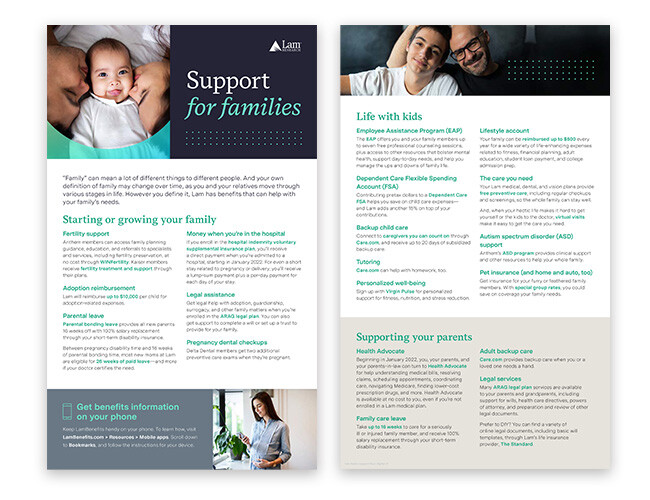
Lam Research inclusive family-focused benefits guide
Lam Research also created a targeted flyer tailored to the needs of LGBTQIA+ employees and their families, which highlights family-building, transgender, and other relevant benefits. Developing a guide specific to their LGBTQIA+ employees helped them earn a spot among the Human Rights Campaign Foundation’s Corporate Equality Index as a best place to work for LGBTQ+ Equality.
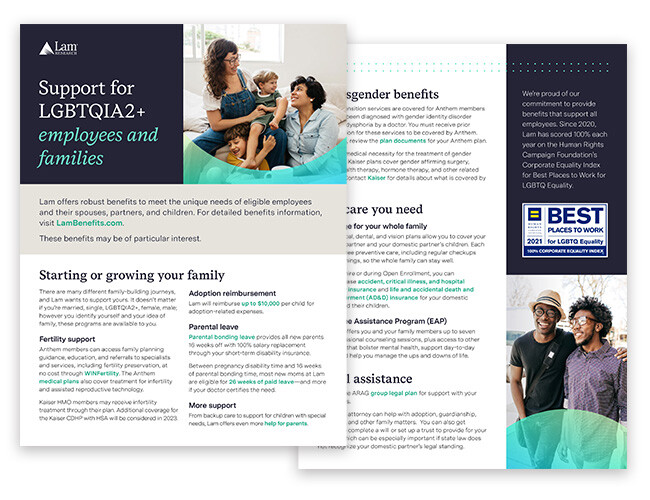
Lam Research LGBTQIA+ benefits guide
Provide Clarity Around Flexibility
People will continue to value flexibility—no matter their physical location, when they work, or how they spend their time while they’re at work. Whether or not you’re changing your policies, setting clear guidelines and outlining your organizations’ expectations will help everyone put them into practice. For example, if you allow your people to work flexible hours, provide parameters for when everyone is expected to be available for meetings. Or, if people are not regularly onsite, outline expectations for how often people should gather in person. Other areas that often need clarification include best practices for stepping away from workstations to attend onsite events (or address personal issues) and disengaging effectively during holidays or time away. Providing specific guidance may help everyone feel more empowered to manage their schedules and will reduce the friction that occurs when people are not on the same page about how things should work. It also reduces the burden on managers to define policies and expectations.
To help one of our clients communicate guidance to managers and employees about flexible work policies, we collaborated on a series of persona-based examples for handling several real-world scenarios. These examples illustrated a new parent returning from parental leave; an employee providing daytime care for their parent; an employee working a four-day workweek to spend time with their teens; and an employee using flex time for a series of medical appointments. The scenarios showed how employees could combine a range of policies and programs to best meet their needs, provided guidelines on how to discuss their flexible work needs with their managers, and outlined how to record their time in a time-tracking system.
Remind People About Mental Health Resources (and Then, Remind Them Again!)
Last year, the U.S. Surgeon General published a 30-page framework promoting mental health and well-being in the workplace. It highlights recent research, including the number of workers who have symptoms of mental health conditions and the impact of those conditions on the workplace. According to a recent Segal analysis, mental health was the biggest theme in employee benefits in 2022.
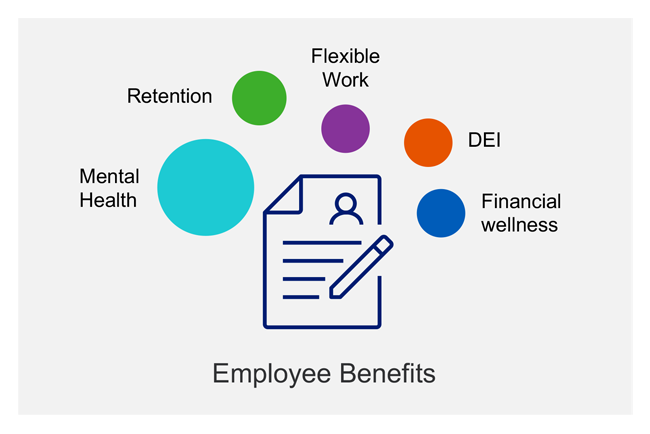
Segal news analysis, 2022
Mental health benefits can be confusing and overwhelming when people need them most. Bringing awareness to the resources you offer and helping people find where to go for care, based on how they’re feeling and how they prefer to interact with providers, can help ensure they’re addressing their needs and getting the most from these benefits. When developing your communications strategy, we recommend creating materials specifically for managers, helping them recognize signs of stress and highlighting relevant resources they can share with employees.
Ensuring that your language resonates with workers and their families is especially important when communicating about mental health. When Marvell wanted to promote their mental health benefits, including their employee assistance program, they wanted to counter the stigmas associated with seeking treatment that could potentially deter employees from engaging with their providers. To overcome this, they focused their messaging on values that would resonate and motivate their people to seek help. Their “Stronger You, Stronger Us” campaign promoted self-care and emphasized how making mental health a priority benefited loved ones.
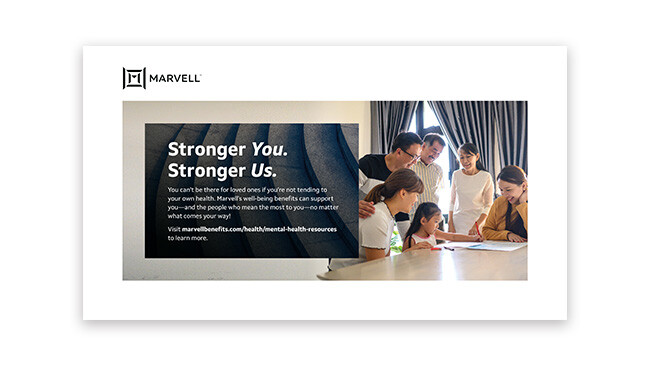
Marvell postcard
Champion Financial Well-Being
Inflation and new legislation—the SECURE 2.0 Act of 2022—will make retirement and financial well-being a hot topic this year. New survey data has indicated that the economy has had a direct impact on workers’ ability to save for retirement, and Americans either reduced or stopped saving altogether in 2022. Yet, at the same time, many employers and plan sponsors have made significant enhancements to their retirement plans and expanded their financial wellness tools and programs to help people save for emergencies and address other financial priorities.
Retirement communications can be so easily bogged down in complex language and processes. When Johns Hopkins University made major enhancements to their retirement plans to make saving and investing easier, they recognized the value in helping people understand why they were making changes. A digital-first campaign, with lots of touchpoints (and time to seek advice), helped their participants understand how they would be affected, where they could go to learn more, and how to access personalized assistance.

Johns Hopkins University animated graphic
Reaffirming the Value of Your Benefits
Decisions about our health, money, and taking care of loved ones, are among the most important we make. Your benefits and total rewards programs play a central role in the lives of your people, helping them through life’s highs and lows. Acknowledging the transformation that’s occurring and sharing resources to navigate their needs and challenges will help your people feel seen and supported.
We’re proud to work with organizations that value their people. If you want to learn more, we’d love to talk.
Read Next
Work with Us
We partner with organizations that value their people first. Let’s talk.
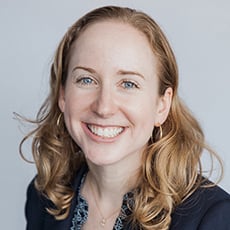
Megan Yost, SVP Engagement Strategist, is a recognized thought leader in benefits communications, particularly in the areas of retirement, financial wellness, and employee engagement.
